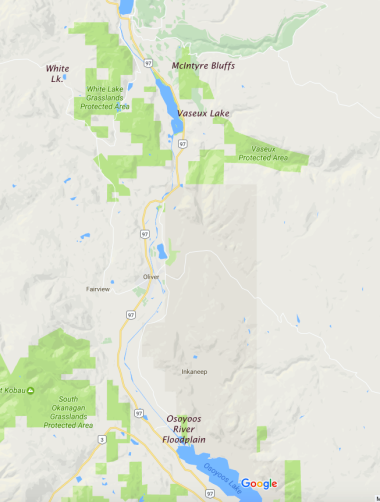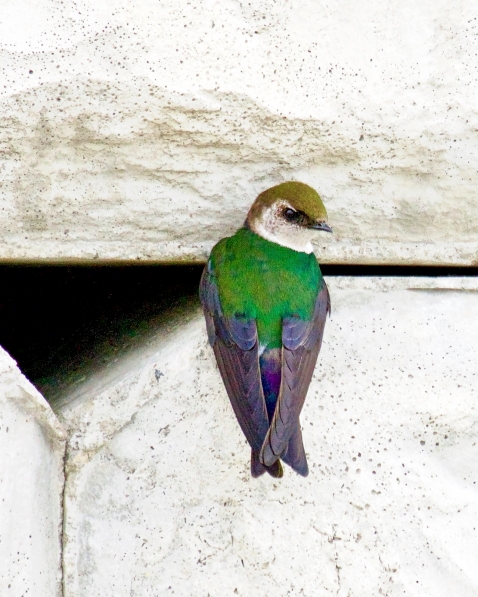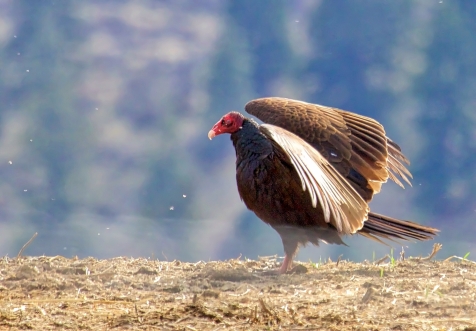For Navigation Help, click here.
Yes, you are meant to sing this posts’s title’s last five words — à la Johnny Horton!
 April 11, 2017: With strong assurance that we had a sunny day at last, Nana and I set out for White Lake and Osoyoos hoping to discover whatever we could. There’s less disappointment with such vague objectives, you know….
April 11, 2017: With strong assurance that we had a sunny day at last, Nana and I set out for White Lake and Osoyoos hoping to discover whatever we could. There’s less disappointment with such vague objectives, you know….
Truth be told (and shouldn’t it always?), we were looking for Mountain Bluebirds (Sialia curricoides), Western Meadowlarks (Sturnella neglecta), and Nature-willing, Yellow-rumped Warblers (Setophaga coronata). Won’t keep you in suspense — we found ’em all right, yet came home with not one decent photo of any of ’em. Not the right day. Nice to see, but far too far off to fotograph!
Click the map at left (or any graphic where the cursor turns to a pointing hand) to enlarge it….
Before you start commiserating, however, let me finish. We did not return empty-memory-carded! At White Lake, right off the bat, I got some decent shots of a Western Bluebird (Sialia mexicana). Actually wished later that I’d spent a little more time there, right across from the parking lot, but we had our targets and figured they were down the trail. We had some fun with meadowlarks, but they were smarter than we. As for the warblers, found that we could do better at home….
Click on any photo in the cluster to enlarge them all….

We didn’t linger long at the lake. Instead we headed south to Osoyoos and famous Road 22 which crosses the Osoyoos River floodplain just north of Osoyoos Lake. At this time of year we can expect to see Ospreys freshly returned from their winter homes in the States, as well as a few other migrants navigating northwards. As we crossed the river and turned south onto the dike road, we saw a flight of Violet-green Swallows (Tachychineta thalassina), a couple of hundred I’d guess, swarming around the bridge area. As we have these at home, we didn’t take time to shoot any….
We did enjoy some success with the Ospreys, however. There are three nests in the floodplain that I’m aware of, and pairs occupied each one . We focused on the largest and most colourful nest, perhaps in the whole Okanagan Valley, maybe in BC, maybe even the world, (!) not that it matters. I’ve provided just three Osprey shots here but if you want more, click this link…. To enlarge the photos, below, click on the —oh, you know…!
On our way back to Oliver, we chose to take the Nimkip Road through Osoyoos Indian Band lands (the road is provincial). Near the junction of Rd. 22 and Sage Rd. sits an old barn and, across the road, some other sadly deteriorated ranch buildings. There we enjoyed great looks at some Say’s Phoebes (Sayornis saya), which seem to be in abundance through their BC range this year. Came away with one acceptable photo.

From Oliver, we drove to Vaseux Lake and up McIntyre Rd. (which Google insists on calling Dulton Creek Rd. Apple Maps, for once, gets it right!) This area is collectively referred to as McIntyre Bluffs (or sometimes Vaseux Bluffs). See map above.
It’s home to a variety of wildlife, both avian and four-legged. We saw (and interacted again) with meadowlarks (still denied the quality shots we got last year). We saw four mule deer, which, after spotting us, turned their attention to a predator they could see, but we couldn’t. Although they stayed put, the here was giving it undivided attention. As the Mulies were too far away to photograph, we didn’t.
On the way up to the ranch on McIntyre Bluff, we stopped to appreciate a rather thin and tired looking California Bighorn ewe. Nana wanted to go look for the rest of the herd, but that came later on our way home….

After turning around, a km or so past the ranch, we were startled on our way back down, just as we approached the feedlot, to find a wake of Turkey Vultures (nine altogether) mostly on the ground but also flying in and out. Must admit that I was struck with vulture fever! Stopping the car as close as I could on the opposite side of the road (with no traffic, that was a mistake!), I rolled down the window and attempted to shoot between strands of the barbed wire fence. While the opportunity was fabulous, the fence was a foil. To get the results I wanted, I had to get out and hope that in their frenzy, the ol’ buzzards would stay put and let me shoot. Alas, not happening on this day! While I got the closest ever to TUVUs, the images produced are not nearly as good as they should be. Were I doing it again, I’d drive to the wrong side of the road close to the fence; I think the TUVUs were oblivious to the machine but not to the man…. One of those situations where one is seen exulting and beard-muttering at the same time!

On the way down the highway, located “our Ewe” again, and observed her and 21 others in the herd, by Nana’s count. There may have been more. No rams, however…. To enlarge any photo below, click on it!



Finally, from the new tower-blind at the Vaseux Lake “Important Birding Area” (a lot more on this fraud some other day!), one last look at Vaseux Lake and Bluff.

For the post on Osoyoos Ospreys only, click this link….

































